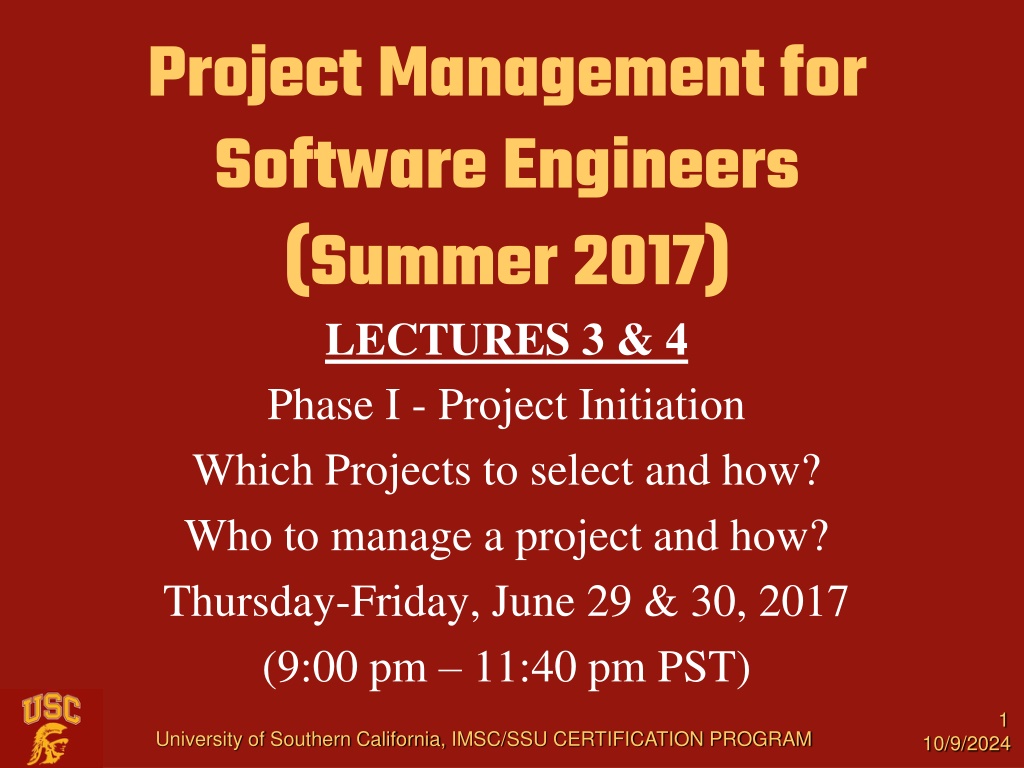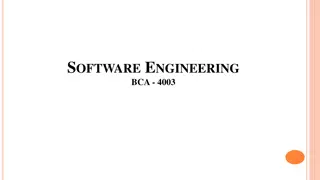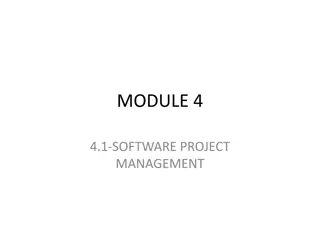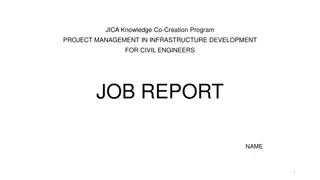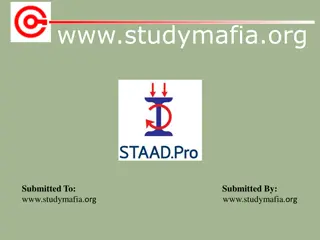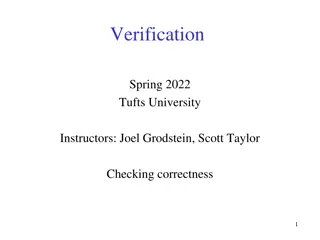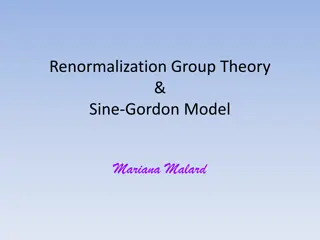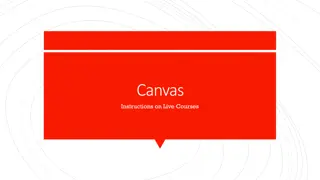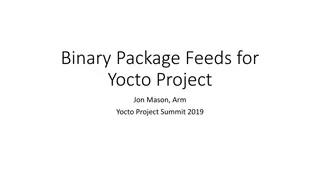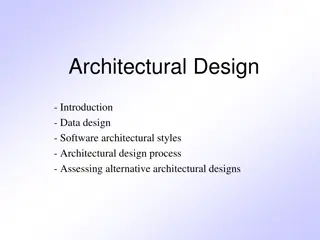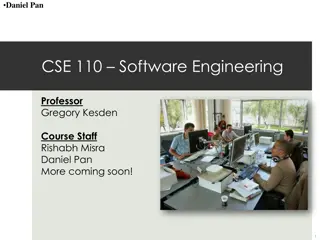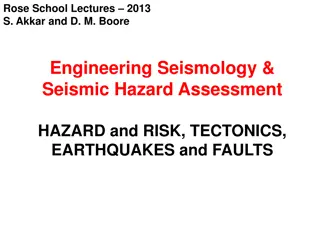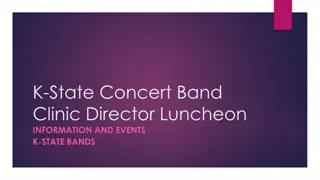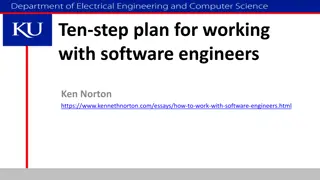Project Management for Software Engineers - Summer 2017 Lectures
Explore the essentials of project initiation in software engineering through lectures focusing on project selection, management, and organizational structures. Dive into project guidelines and presentation milestones, alongside logistics for a career day mini-project and grading activities. Gain insights into project objectives and management strategies within organizational contexts.
- Project Management
- Software Engineers
- Project Initiation
- Organizational Structures
- Career Development
Download Presentation

Please find below an Image/Link to download the presentation.
The content on the website is provided AS IS for your information and personal use only. It may not be sold, licensed, or shared on other websites without obtaining consent from the author. Download presentation by click this link. If you encounter any issues during the download, it is possible that the publisher has removed the file from their server.
E N D
Presentation Transcript
Project Management for Software Engineers (Summer 2017) LECTURES 3 & 4 Phase I - Project Initiation Which Projects to select and how? Who to manage a project and how? Thursday-Friday, June 29 & 30, 2017 (9:00 pm 11:40 pm PST) 1 University of Southern California, IMSC/SSU CERTIFICATION PROGRAM 10/9/2024
Logistics Excel version of the Career Day mini-project to be completed today You will start the MS-Project version today Project teams are formed and project guidelines will be provided by next Wednesday You will have three presentations: 50% time progress (July 17), project leader, 10 min 75% time progress (July 21) , project leader, 10 min 100% time progress (July 26) , ALL members, 20 min 2 University of Southern California, IMSC/SSU CERTIFICATION PROGRAM 10/9/2024
Logistics - Grading Homework Assignments (200 points) HW #1 (20 points) Assigned due to TA on 07/05/16 There will be total of 4-5 homework assignments Exams (500 points) Midterm (200 points) Multiple Choice & Descriptive Final (300 points) Multiple Choice &/or Descriptive Term Project, starting on 07/05 (300 points) Teams to be formed & projects to be selected on 07/05 Projects will be evaluated progressively 3 presentations at 50%, 75%, and 100% time progress Project guidelines will be provided by 07/05 3 University of Southern California, IMSC/SSU CERTIFICATION PROGRAM 10/9/2024
Projects within Organizations Procedures Policies, Rules, P5 S.O. Mission Vision S.O. S.O. S.O. S.O. P6 P4 Culture, Norms, Values PROJECT #1 What is it, What are its objectives, and how to manage it? 4 University of Southern California, IMSC/SSU CERTIFICATION PROGRAM 10/9/2024
Organizational Continuum* Functional Matrix Project FIND THE BEST STRUCTURE FOR YOUR COMPANY 100% 0% % Staff in Departments Pure Functional % Staff in Project Task Force Weak Matrix Part- Time Project Coordinator Moderate Matrix Strong Matrix 0% 100% Full-Time Project Manager Full-Time Project Office Separate Team No Project Coordinator *Adopted from Organizational Alternatives for Project Management, Robert Youker, Project Management Quarterly, V. VIII, No. 1 (March 1975) University of Southern California, Industrial & Systems Engineering 5 10/9/2024
Characteristics Transition Functional Matrix Project Views: Independent Functions Long-Term Fiscal Planning System Thinking Long & Short-Term Strategic Planning Independent Projects Short-Term Project Planning Pros Stability Standardization Corporate Memory Clear responsibilities & authorities Teamwork Spirit Cross-functional Cooperation Aligning Organization goals & project goals Adaptability Flexibility Empowered Team KSA Diversity 6 University of Southern California, Industrial & Systems Engineering 10/9/2024
Project Selection Methods(1) Non-Numerical Sacred Cow Operating Necessity Competing Necessity Product-Line Extension Comparative Benefit Sustainability Numerical Payback period Discounted Cash flows Internal Rate of Return Profitability Index (C/B) Others (1) Meredith & Mantel, pp. 45-62 7 University of Southern California, IMSC/SSU CERTIFICATION PROGRAM 10/9/2024
Develop Project Requirements Translate Voice Of Customer (Y) to Critical To Quality requirements (X) V.O.C. Example: The X s define the top level of your W.B.S. C.T.Q. 8 University of Southern California, IMSC/SSU CERTIFICATION PROGRAM 10/9/2024
Project selection/categorization Using Q-Sort technique to prioritize options (projects): An iterative process by multiple users Exercise: Using Card-sort technique to design a website List of website features are provided in individual cards (which company!?) Work together to categorize them 9 University of Southern California, IMSC/SSU CERTIFICATION PROGRAM 10/9/2024
PMs job through Life-Cycle Responsive to ALL stakeholders Identify potential problems, before they materialize Find and correct materialized problems before they become uncontrollable (or dramatized) Align project goals with company goals (prevent sub-optimization) Play all chaos games properly and timely, understanding client s (changing) priorities 10 University of Southern California, IMSC/SSU CERTIFICATION PROGRAM 10/9/2024
Project Manager or Project Leader!? Define, communicate, and commit to meeting project directions, goals, and expectations Review & Improve project Performance Effective use of resources Feedback People Others Internal External Lead & Manage Manage (Thompson, P. 290) Lead & Manage 11 University of Southern California, IMSC/SSU CERTIFICATION PROGRAM 10/9/2024
Transforming the power Authentic cohesion (at the right level) results in truly appropriate empowerment Trust Resources Adequate Cohesion Appropriate Empowerment But empowering PM properly is very hard Matrix weaknesses, temporal nature, resource scarcity, uncontrollability/unpredictability, WHOM TO REWARD/BLAME!? University of Southern California, IMSC/SSU CERTIFICATION PROGRAM 10/9/2024 12
BAD project manager (on the Extremes) Micromanagement (too specialized) Mislead (too generalized) Na ve optimism (underestimate resources & risks) Paranoid pessimism (overestimate resources & risks) Over-organized (Highly educated, but impractical) Under-organized (Hands-on, but ignorant) Too Generous (lose money) costs add up fast Too Stingy (lose relationship) Can t see the big picture Too transparent (losing internal faith) Too political (losing external respect) University of Southern California, IMSC/SSU CERTIFICATION PROGRAM 10/9/2024 13
Example Career Paths for PM Software Developer University of Southern California, Industrial & Systems Engineering 10/9/2024 14
Together Everyone Achieves More T EAM Katzenbech & Smith 1993: Small number of people with complementary skills who are committed to a common purpose, measurable performance goals, and approach for which they are mutually accountable Sundstrom et al. (1990): An independent collection of individuals who share responsibility for specific outcomes Holpp (1999): Group of people working together toward specific objectives within a defined operational sphere 15 University of Southern California, IMSC/SSU CERTIFICATION PROGRAM 10/9/2024
Key Features of Teams Objectives: Commit a Shared Goals (Measurable) aligned with M/V/V People: not too few, not too many Interdependence: Complementary KSA (No one s perfect) Empowerment: Authority & Responsibility Accountability Longevity: Not too long, not too short (Stable, but not static) Boundaries: Membership is explicitly identifiable (some implicit fuzziness) Relatedness: The team is a part of a system, with a grander purpose 16 University of Southern California, IMSC/SSU CERTIFICATION PROGRAM 10/9/2024
Why Teams Fail!? THOMPSON (PP. 13 16) HOLPP (PP. 45 54) The Dump TEAM The Magic word! And above all, Misattribution Error TEAM may not even be the right answer! Bait-And-Switch Task KSA or Team KSA!? Read My Mind Lose the Battle or the War ? Yes, But No/Bad/Good Conflict? Try it You ll Like It Sometimes Charismatic Leadership! Together Everyone gets Addles More FAILED! Team or Teamwork? Impose or Build Trust? 17 University of Southern California, IMSC/SSU CERTIFICATION PROGRAM 10/9/2024
Team Structure Continuum (Thompson P. 8 & Holpp P. 25) Manager-Led Self-Managing Self-Directing Self-Governing THE GENIUS OF AND : RIGHT EMPOWERMENT Democratic Autocratic Autonomy Creativity Morale Commitment Accountability Shared Vision Risk Mitigation Goals Aligned with other teams / company Control from top Assessablity Economy 18 University of Southern California, IMSC/SSU CERTIFICATION PROGRAM 10/9/2024
Hackman & Oldham At the Individual level: Perception Perception Job Characteristics Psychological State Performance outcome Skill Variety High motivation Meaningfulness of the work Task identity High job performance Task Significance High job satisfaction Responsibility for outcomes Autonomy Low absenteeism & turnover Knowledge of work results Feedback Motivation Motivation 19 University of Southern California, IMSC/SSU CERTIFICATION PROGRAM 10/9/2024
Descriptive-Prescriptive Model At the Team level: Perception Perception Team Essential Conditions Team Performance Context Organizational Context Ability: KSA Productivity Cohesion Team Motivation Learning Design Integration Strategy Team Future Lectures Culture Motivation Motivation 20 University of Southern California, Industrial & Systems Engineering 10/9/2024
Motivation & Flow High Finding flow : Csikszentmihalyi, M. (1990) ANXIETY (CHOCK) T.1 T.2 CHALLENGE Team Exercise #2: Where do exercise #1 teams fall? T.4 T.3 (6 Individuals) I.2 Focus on the Process or on the Results? BORDOM (FRUSTRATION) I.1 I.3 Perception or fact? (Integration) Low SKILL High 21 University of Southern California, Industrial & Systems Engineering 10/9/2024
